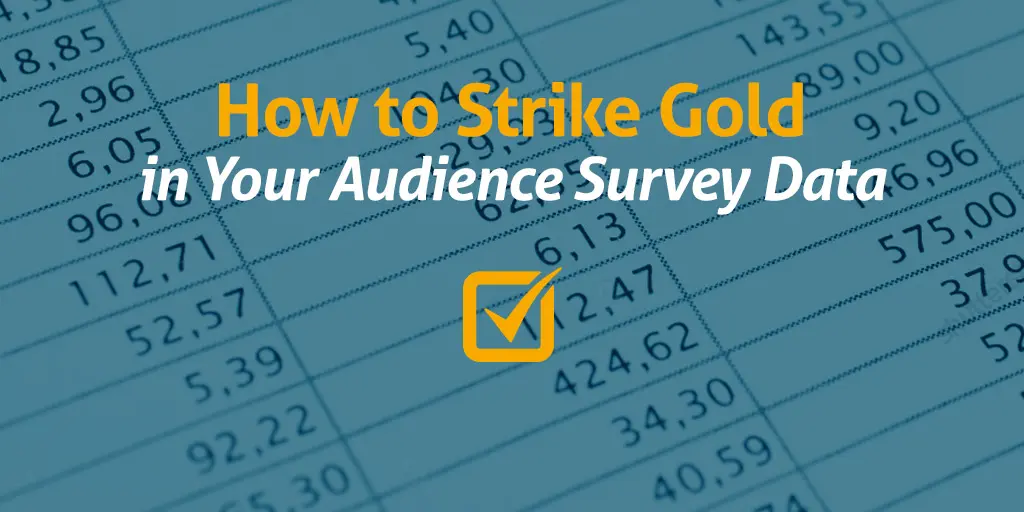
You can learn a lot from surveys. You can learn why people are attracted to your brand and then enhance those features. You can find out what’s missing from your offering and then tweak it to deliver exactly what your audience needs or wants. Also, you can use surveys to learn which demographic is most likely to engage with you. This will help you create targeted marketing that zeroes in on the people who will buy from you.
You can get all of this, and more, from a survey.
But how?
In this post, we’re going to share how to squeeze the best data out of simple surveys that you can attach to your blog posts, email newsletters, contests, and more. Who’s with me? It’s time to play the family feud! (wait, wrong show.)
What’s a survey?
Let’s talk briefly about the difference between a survey and a poll.
A survey is a list of questions.
A poll is generally one question.
Here’s a list of winning surveys that hit the mark. Subscribe to receive this extra resource.
Why do you need a survey?
As we talked about before briefly, surveys are a quick and easy way to extract information from your audience. It’s not that customers are unwilling to provide feedback, you just didn’t ask. You’re not burdening them by asking these questions, you’re giving them the opportunity to tell you what works and what doesn’t.
It’s not that customers are unwilling to provide feedback, you just didn’t ask. Click To Tweet
For this reason, you need surveys – a lot of them. Just like you need more than one landing page, you need more than one survey. Create targeted surveys (more about this later) to glean as much information as possible.
Surveys can give you product feedback, help you with customer satisfaction, direct your marketing strategy, and more. Surveys are a vital part of your customer feedback loop. Without them, you’re throwing rocks in the dark, and not knowing what you hit. Hopefully, you’re not in a glass house when you do.
What is the purpose of your survey?
Every survey should have a purpose. For this article, we’ll focus on audience data.
Let’s say you’ve set out to create a series of surveys to learn more about your audience. What do you want to learn about them? If you use a web tracking tool like Google Analytics, you probably know the basics (age, gender, interests). However, surveys allow you to dig deeper into those demographics.
For example, you can ask the following questions:
Asking these and similar questions can help you better understand your audience and create more relevant information for them.
We know that the number one reason why people bounce from your site is relevancy. When you understand who you’re attracting and what they’re looking for, you can reduce your bounce rate through targeted content.
Along with demographic-type questions, you can ask about motivation and expectation. For example, a good question to ask is, “Did you find what you were looking for from this blog post?” It’s a simple yes or no question, but a powerful indicator of whether or not you’re on target.
You can also test the waters for future products or services. Not sure if your audience will bite on that new project you’re creating? Fish for interest.
Start with a question like, “Would you pay for a product that helps you solve this (insert problem)? Once you get enough feedback, you can then ask a question like, “How much would you pay for a product that solves (insert problem)?” Give the multiple choice range of answers.
You may surprised by how much people say they are willing to pay for a product. Of course, this is only the first step (along with market research), but hopefully you’re starting to see how surveys can give you incredible insight into the mind of your audience.
What types of surveys can you use?
There are four types of question and answer style surveys that work best for collecting audience data. Let’s take a look at each and then determine which one (or ones) are right for your audience.
1. Categorical or Nominal
The respondent chooses one category over another. For example:
Do you like cats or dogs?
1- Cats; 2- Dogs; 3- Ron Swanson

2. Ordinal
The respondent answers the question how much? For example:
How likely are you to tell your friends about us?
1- Heck yeah!; 2- There’s a 50/50 chance; 3- I’m erasing all memory of you right now.
3. Interval
Ordered in a range. For example:
What is your age?
a. 18 – 24; b. 25 – 34; c. 35 – 44; d. 45+
4. Essay Style/ Open Ended –
You expect an in-depth answer instead of a yes or no. For example:
Why do you love me?
______
Create personalized surveys
Okay, so that was awkward – now let’s move on to why you should personalize your surveys and how to do so.
Not everyone is going to want the same thing from your brand, especially if you offer a wide variety of products. Some people may want to glean from your large library of information (i.e. your blog), others may just want to purchase a one-on-one consultation service with you. Moreover, some just love your email courses.
Why ask these three people the same question?
As for how to do it, I can summarize it in one word: segmentation. We’ve spoken in depth about segmentation before. Basically, you know that your audience has different reasons for being there. Do your best to separate your audience into groups and then target them with relevant surveys.
Survey Don’ts
-Don’t ask with a bias
In other words, don’t lead the survey taker by asking biased questions like, “How much does this day suck?” You presuppose that the day sucks.
-Don’t forget to incentivize it
It’s not always necessary to dangle a carrot in exchange for survey participation, but sometimes it can help. Approximately a third of survey takers are motivated by a prize or discount.
-Don’t set yourself up for generic answers
Instead of saying “How’s the weather today” ask “How would you rate the weather today on a scale of 1-10, with 10 being the best weather you’ve ever experienced”
-Don’t forget to include all possible answers, including “other” or “prefer not to answer.”
Allow for gray areas instead of forcing respondents into absolutes.
-Don’t make the survey too long
A survey that goes beyond five minutes is tempting fate, and a survey that hits 10 minutes is asking to be abandoned. Keep your survey short and sweet for maximum response.
-Don’t expect a huge percentage of participation
10 questions to ask
We’ll leave you with 10 questions you can potentially ask in your surveys. These are perennial favorites because they can provide deeper insight into your audience.
Final Thoughts
Go forth and create your simple survey and the reap the benefits of audience insight. With this insight, you can create a sharper, more targeted product, service, landing page, blog: you name it. Get started with your simple survey now.
Here’s a list of winning surveys that hit the mark. Subscribe to receive this extra resource.